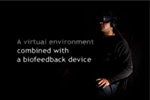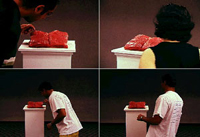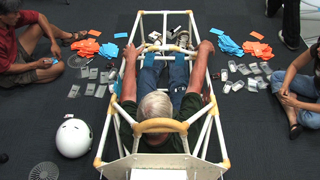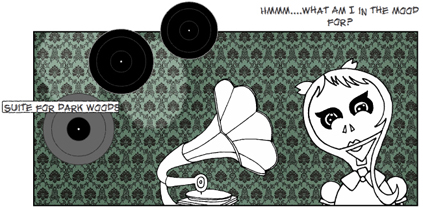Projects
Transforming Pain
Walking Meditation
Banyan Tree
Other Projects
Meditation Chamber
VR Environment that responds to a person's state by Diane Gromala
The Meditation Chamber is an immersive VR environment that provides users with real-time feedback. Wearing a head-mounted
display and biofeedback device, users are guided through a series of relaxation and meditation techniques. In real-time,
the audio and visuals are synced to the users' continually changing physiological states (respiration, pulse rate and sweat
gland activity (a measure of calmness)). As users' approach meditative states, the hypnotic visuals dissolve to moving
mist and darkness as the user relaxes. Exhibited at SIGGRAPH's Emerging Technologies, and seen on CNN.
MeatBook
A project that provokes users' senses of their visceral responses by Diane Gromala
A time-based (that is, decaying) slab of meat, constructed as a book, is embedded with various sensors that cause the meat
to react and quiver as the viewer approaches it. The reanimated flesh also responds with other movements and sound when
users touch it. The next stage of development includes artificial intelligence and explores notions of generative art.
Neurofloat
A novel interface for exploring brain data by Steven Barnes & Meehae Song
The goal of the NeuroFloat project is to create an interactive system that uses electroencephalographic (EEG) or other
biological signals obtained from the user as a primary input for navigation through an immersive real-time 3-D visualization
of various regions of the human brain. One of our primary goals is to create a system where the brain-computer interface
is intrinsically related to content of the virtual-reality (VR) environment that it interfaces with. Accordingly, we have
chosen to develop multiple VR environments that collectively represent a tour through the early stages of the users very
own visual system.
Unconventional Racecar Interfaces
A tool for creating interfaces with racecar drivers by Jack Sam
A person's psychological and physiological states are different when driving a racecar from when commuting to work. The
goal of this research method and its tools is to understand the experience of racing and to use this knowledge to design
novel interfaces for racecars.
Scarlet Skellen and the Absent Urchins
A novel interface that changes aesthetics based on affective states by Angela Tomizu & Joshua Tanenbaum
Scarlet Skellen and the Absent Urchins is an interactive, multimedia comic book that employs a user modeling approach
for affective interaction.
Biomorphic Type
BioMorphic Typography is Gromala's term for a family of fonts that respond, in real-time, to a user's changing physical states, as measured by a biofeedback device. Rather than one typeface, it is a postmodern pastiche of many different fonts that are continually morphing. So, for example, the font "throbs" as the user's/writer's heart beats, expands as the user breathes, and "spikes" according to galvanic skin response. In this way, users become aware of their autonomic states -- physiological states that usually remain under our conscious awareness. This project is part of a larger initiative, Design for the Senses. The goal is to develop new approaches to experiential design that focus on the senses and the phenomenological history of the body.





